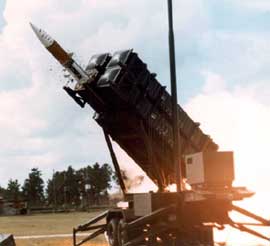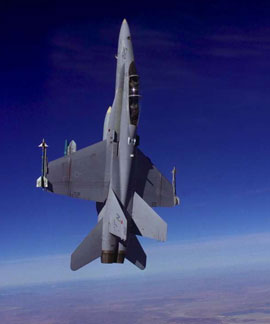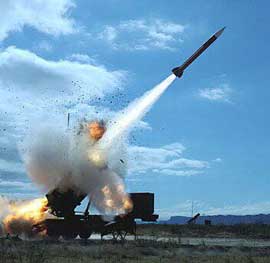|
By Robert Riggs
 An
investigation by CBS 11 News (KTVT-TV Dallas/Fort Worth)
questions, “Did chronic problems with the U.S.
Army’s newly upgraded three billion dollar Raytheon
built Patriot Missile system contribute to shooting down
the only U.S. Navy pilot lost during combat in Iraq?” An
investigation by CBS 11 News (KTVT-TV Dallas/Fort Worth)
questions, “Did chronic problems with the U.S.
Army’s newly upgraded three billion dollar Raytheon
built Patriot Missile system contribute to shooting down
the only U.S. Navy pilot lost during combat in Iraq?”
The Army has uniformly praised the
Patriot Missile system’s performance during the war,
shooting down all nine Iraqi tactical ballistic missiles
(TBM’s) it engaged.
Until now, the circumstances of the
Patriot fratricide that killed 30-year-old Navy
Lieutenant Nathan White of Abilene, Texas on April 2nd
of last year have been cloaked in the secrecy of an Army
investigation. So has the March 2003 Patriot Missile
downing of a British RAF Tornado Bomber ten days
earlier.
A CBS-11 News investigation conducted
by reporter Robert Riggs, who was embedded with a
Patriot Missile battery during the war, has uncovered
evidence that friendly aircraft showed up on Patriot
radars as incoming enemy missiles. Yet, Patriot
operators on the ground were not alerted, nor coalition
aircrews above, that similar problems had surfaced in a
Patriot Missile unit stationed in Jordan in the months
before the invasion.
In Lieutenant White’s last email
sent home from the aircraft carrier Kitty Hawk, Dennis
White says the only warning his son and fellow pilots
ever received was the chilling news some four days
earlier that a Patriot Missile had blasted apart a
British RAF Tornado, killing its two crew members. An
email that Lt. White sent to his mother in Abilene
shortly before a Patriot Missile blew up his own plane
talked about, “steering clear of the Patriot
batteries.”
 On
April 2, 2003, a Patriot Missile fired by fellow
American soldiers in Iraq sheared off the cockpit of Lt.
White’s F-18, and the smoldering tail of his F-18
crashed into a south-central Iraq lake located west of
Karbala. More than one hundred Navy, Marine, Army, and
Special Operations launched a massive search and rescue
operation. They recovered Lt. White’s body floating
near the eastern bank of the lake on April 12, 2003. On
April 2, 2003, a Patriot Missile fired by fellow
American soldiers in Iraq sheared off the cockpit of Lt.
White’s F-18, and the smoldering tail of his F-18
crashed into a south-central Iraq lake located west of
Karbala. More than one hundred Navy, Marine, Army, and
Special Operations launched a massive search and rescue
operation. They recovered Lt. White’s body floating
near the eastern bank of the lake on April 12, 2003.
Lt. White was buried at the Arlington
National Cemetery on April 24th with full military
honors. A wife and three children survive him.
At his home in Abilene, Dennis White
proudly chronicles his son’s life with snapshots from
their Boy Scout campouts, memories of Nathan White’s
work as a Mormon missionary in Japan, and flight deck
photographs of the beloved F-18 pilot nicknamed “OJ”.
Dennis White is a former Air Force
pilot who flew C-130 cargo planes during the Vietnam
War. He also flew with the current Governor of Texas,
Rick Perry. White has patiently waited ten months for an
official explanation of how a Patriot missile killed his
son. White stresses that he will do what he can to
prevent another Patriot fratricide, or “blue on
blue” incident, from taking the life of anyone
else’s son or daughter.
Last February, an embedded news team
from CBS 11 (KTVT in Dallas) witnessed chronic problems
with the Patriot missile system. CBS 11 News reporter
Robert Riggs, photographer/editor, Billy Sexton and
field producer, Steve Narissi were embedded with the 5th
Battalion 52nd Air Defense Artillery (5-52 ADA) which
had been deployed to Kuwait from Fort Bliss in El Paso,
Texas.
The CBS 11 News team first witnessed
problems on the Patriot’s radar shortly after arriving
at Camp Virginia in Kuwait, headquarters’ for the
Army’s V Corps. Ground rules for embedded reporters at
that time prohibited them from reporting about the
problems.
Inside, the 5-52 ADA’s Tactical
Operations Center (TOC) soldiers focused on what
appeared on their radar display screens as the symbol of
an incoming tactical ballistic missile (TBM) from Iraq.
Suddenly, an employee of Raytheon, the Patriot’s
defense contractor, threw open the door to the TOC and
yelled, “Don’t shoot! Don’t shoot!” Soldiers
present breathed sighs of relief and told our news crew
that, “We just came close to shooting down a Navy
F-18”.
A few days earlier BG Howard Bromberg
had expressed strong confidence in the Patriot system
during an interview with CBS 11 at Camp Doha in his
headquarters for the 32nd Army Air and Missile Defense
Command. Bromberg, speaking about the newly fielded
PAC-3 missile system said, “I was involved with
testing before so I am very comfortable with the
capability we have here right now. I think it was more
than adequate, numerous test shots before we decided to
field this system. So I am comfortable with that”.
Yet, CBS-11 has learned that the
American military had indication that there were
problems with the Patriot system much earlier.
John Pike of the Washington DC-based
think tank Global Security said he discovered a
confidential “Initial Lessons Learned” power point
report about the Patriot’s problems that was
inadvertently posted on the Army’s Fort Bliss website
in November 2003. Pike posted the report on his Global
Security-dot-org before the Army realized its mistake
and deleted it.
The report states that a Patriot
Missile battery in Jordan before the invasion
experienced problems with false enemy missile tracks.
“This information was not shared with Patriot units
supporting the Marine Expeditionary Force in
Kuwait…had the…experience been shared throughout the
(area of responsibility) then the problem…could have
been minimized,” The internal Army report, published
six months after the invasion, stated.
Pike said complex computerized weapon
systems can-and did, in the Patriot’s case-act up in
mysterious ways, “The problem was that there was not a
single ghost in the machine but that it was a haunted
house. They had lots of ghosts. Every radar was
reporting a separate track and if you get enough data
input the computer is going to get awfully confused.”
Ted Postol, the MIT science professor
who testified before Congress about problems he found
with the Patriot’s performance during the 1991 Gulf
War, says the Army’s Patriot organization “has a
long history of failing to fix problems and failing to
acknowledge problems”. Postol adds, “The fact that
they know or knew that this was a problem was going on,
raises questions of negligence.”
A Raytheon spokesman referred
questions about the Patriot’s performance to the Army.
An Army spokesman at the Pentagon and the spokeswoman at
Fort Bliss say their commanders cannot discuss what
happened until the two fratricide investigations are
finished.
Meanwhile, the Army’s official,
widely published report on the Patriot’s war record
does not acknowledge that hundreds of false missile
tracks occurred and that both downed coalition fighters
showed up on Patriot Missile radar scopes as enemy
tactical ballistic missiles (TBM’s).
In northern Kuwait in the weeks before
the invasion, unfolding problems with the 5-52 ADA’s
Patriot missile batteries became evident to CBS-11’s
news team.
 Echo
Battery’s launchers marked the first line of defense
against Saddam Hussein’s SCUDS and other types of
tactical ballistic missiles, and tensions were rising
among U.S. soldiers. Echo
Battery’s launchers marked the first line of defense
against Saddam Hussein’s SCUDS and other types of
tactical ballistic missiles, and tensions were rising
among U.S. soldiers.
Intelligence briefings during the
battalion’s daily battle updates indicated Saddam
would likely launch a preemptive missile attack tipped
with weapons of mass destruction. Captain David McCoy,
the commander of Echo battery, stressed the importance
of the Patriot’s protection against Iraq’s TBM’s
saying, “It can disrupt the battlefield. It can slow
down friendly forces. Cause immense casualties. Mass
casualties. It’s just something you don’t want to be
hit with and the threat is always there that he can load
those missiles with that type of agents whether it be
chemical or biological. And we are the ones who are
going to knock it down”.
That threat was felt most intensely
inside Echo Battery’s war wagon called an Engagement
Control Station (ECS). Inside a compartment mounted on a
truck, a pair of Echo Battery’s soldiers sat side by
side at battle stations watching their individual
radarscopes for signs of trouble. From his right seat
position, Lt. James Chase, the Tactical Control Officer
told CBS 11 that a big mental challenge in a combat
situation was, “being a quick thinker. As well as
staying calm and making the right decision”.
In the left seat, Specialist Terrence
Barnes, the Tactical Control Assistant, described how he
would manipulate the radar’s joystick to “hook” a
target to start the process of identifying if it was a
friend or foe, “You’ve got to be quick and you’ve
got to be a fast thinker. You’ve got to be able to
react fast”. The Patriot soldiers would have precious
few minutes if not seconds to try to shoot down an Iraqi
missile moving up to three times the speed of sound.
Neither of the soldiers was involved in the later
friendly fire incident.
Patriot radarscopes began showing
friendly aircraft as enemy TBM’s. More often, the
radar showed false or what the Army called
“spurious” missile tracks that did not exist. The
CBS-11 team witnessed heart-pounding moments when false
missile targets appeared on the radar screens.
Commanders and soldiers told CBS-11
they had never seen anything like the ghost missiles
until operating in Kuwait. We observed one battalion
Battle Captain writing daily reports about the problem,
which he said, were being sent to higher command.
After repeated false missile incidents
CBS-11 was present when Battalion Commander LTC Joe
Fischetti confronted a Raytheon representative attached
to the unit. Fischetti demanded answers. “You guys are
suppose to be the geniuses,” Fischetti said
forcefully, demanding: “Tell me what’s wrong!”
CBS-11 witnessed briefings in which
Raytheon’s on site trainer explained that he was
unable to get the Patriot system to replicate the false
missile tracks for training purposes. The absence of
additional help appeared particularly frustrating to
Echo Battery. Colonel Heidi Brown, Commander of the 31st
Air Defense Artillery Brigade, had heaped praise on
Echo’s qualifications saying, “This is a great
battery. They are very motivated. There are very few
Patriot batteries in the world. Everyone wants them.
Everyone wants their piece of ground covered.”
The battalion’s soldiers struggled
to figure out how to tell the difference between a false
missile track and a real one. And when the Iraqis
started firing real missiles, there appeared to be some
uncertainty among the Patriot operators about the
sophisticated weapons system.
On March 20, 2003, one of Echo
Battery’s counterparts, Delta Battery of the 11th
Brigade Air Defense Artillery, shot down the first Iraqi
missile over Kuwait. Army commanders praised the Patriot
missile system for protecting four thousand soldiers and
one hundred helicopters from the 101st Airborne based at
a tactical assembly area named Thunder.
But during an interview shortly after
that first engagement, a soldier in the Engagement
Control Station (ECS) told CBS -11 that at first he
wondered if the missile was real.
The following day, Echo Battery moved
out as part of the spearhead of the massive ground
invasion force. It was the first Patriot unit to cross
into Iraq. Echo’s mission was to charge deep into Iraq
to near Najaf to provide an umbrella of air coverage for
the desert base of the 101st Airborne Division. The Army
planned to initially position forty percent of its
helicopters there.
Despite the false missile track
readings on the Patriot’s radar, CBS-11 did not
witness any change in the rules of engagement. Patriots
were on “weapons free,” meaning a battalion could
launch without higher approval.
On the third day of the invasion, Echo
learned that Charley Battery, which was under command of
the 11th Brigade, shot down a British Tornado returning
to Kuwait from a mission in Iraq.
Initially , word of the catastrophe
reached Echo Battery that fault lay with the two dead
crewmembers. It has since been reported in published
news accounts that the bomber crew had failed to turn on
the IFF, a special device designed to signal coalition
forces that theirs was a friendly aircraft.
But CBS-11 has learned from Army
sources that Charley Battery’s radar showed the
British jet as an incoming enemy cruise missile.
On April 2, 2003, just after midnight,
Lt. White was completing a bombing raid over
south-central Iraq. He was high over a strategic area
known as the Karbola Gap, a chokepoint on the invasion
route to Baghdad. If the Iraqis could mount a successful
defense there, the invasion could be thwarted, at least
temporarily.
Prior to the start of the war, CBS-11
was present when the 5-52 had received intelligence
briefings that had predicted heavy attacks with missiles
loaded with chemical warheads in the Karbola Gap.
The CBS-11 news team departed Echo
Battery, but sources describe what happened next.
The soldiers of Echo and other Patriot
batteries were on high alert. Their radar’s were
clearly showing friendly aircraft in the region at the
time. But the, sources say, Echo’s Patriot radar
scopes displayed Lt. White’s Navy F-18 as a highly
credible enemy ballistic missile symbol that did not
resemble any false missile track that had been seen
before.
The symbol indicated that the TBM was
being tracked on radar by multiple Patriot batteries.
Moreover, the Patriot radar showed a launch point in
Iraq and an impact point on none other than Echo
Battery’s position.
Sources say there was further
corroboration that an enemy missile had been launched
and was headed Echo’s way.
The ICC for the 5-52 ADA also showed
the TBM track and a second target that the radar
identified as unknown. The Information and Coordination
Central (ICC), the battalion’s mobile command and
control center for the Patriot’s air battle, confirmed
the enemy missile track.
With precious seconds remaining before
the incoming missile’s predicted impact, an officer in
the ICC issued the order for Echo Battery to bring its
launchers up to operate. That in effect “cocked the
gun” to set in motion a sequence leading to an
automated launch of two missiles.
Under ideal conditions, the soldiers
could have obtained additional information about the
attributes of the target. By pressing a tab called track
amplification data, it would tell whether the target was
flying as fast as a missile or as slow as an aircraft.
But before the data could be checked, the Patriots were
leaving the launchers at supersonic speed.
Inside the war wagon a few seconds
later, radars showed that the TBM target had been
destroyed. But unbeknownst to the euphoric crews of Echo
and the 5-52, what was left of Lt. White and his Navy
F-18 was hurtling down into a lake.
Their euphoria, however was short
lived. About 100 miles south of Echo, the Patriot crew
of Alpha Battery narrowly averted shooting down Lt.
White’s lead F-18, which was still flying. The second
F-18 had suddenly turned from an unknown target symbol
on the radarscope into another enemy TBM. Being further
to the rear, Alpha had more time to examine their flight
data, sources say.
And despite orders to launch, officers
waited to closer examine the flight data for the TBM
target.
Army sources say the false missile
tracks continued the next day. Echo Battery’s radar
displayed fifteen TBM’s at once and the battery had
lost communication with the ICC for additional
confirmation. Echo had the authority to shoot in that
situation but its air battle commanders did not trust
the system to take any action. Sources say the TBM’s
tracks were believed to have been friendly aircraft.
For the Army’s fratricide
investigation, it is nearly impossible to accurately
reconstruct the events. None of the electronic data
recorders in the 5-52 were working. CBS-11 News team had
heard frequent complaints from soldiers that the data
recorders had a long history of breaking down and that
spares were in short supply.
Lt. White’s father, Dennis White,
decries the Army’s failure to make all Coalition
pilots aware that the Patriot radars were showing
friendly aircraft as enemy missiles.
“I feel absolutely that they
didn’t include the Navy or the Air Force about what
the potential dangers were and how to avoid it.”
White says he has deep compassion for
the Army soldiers involved in the incident, “I wish I
could talk to them. I don’t know that I could put
their heart at rest or at ease, but again I know that
they were doing their level best under a very trying
condition.”
And, he said he worries that low
ranking soldiers who were there may be made scapegoats
for technical problems.
Sources say the false missile track
problem has continued in recent months during training
exercises at Fort Bliss. The Army’s official version
of the Patriot’s war record makes no mention that
friendly aircraft were being identified on radar as
enemy missiles.
White says he is worried that more
pilots may be place in harm’s way, “To pretend that
it doesn’t exist. That worries me because I can see,
we are going to have some other mom and dad out there
who are sitting comfortably in their home and they do
not know who they are yet but they are going to
understand exactly how we feel.”
© Copyright 2004, MMIV, CBS
Broadcasting Inc.
|